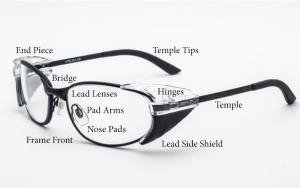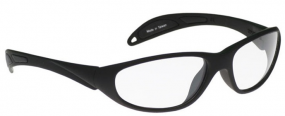It is important to protect your eyes from potential radiation exposure and reduce the risk of eye injuries. When selecting a pair of lead eyeglasses it is important to understand the various parts of the lead glasses. Once you have purchased your lead eyeglasses you may be wearing them for the majority of your workday so you will want to ensure that you find the most comfortable style frame possible. Below are common terms used to describe the different parts and sections of the lead eyeglasses.
Frame Front: The frame front is the section of the lead eyeglass that holds the lenses in place and bridges the top of the nose.
Eye Wire/Rim: The eye wire or eye rim is the part of the frame front where the lead lenses are inserted.
Bridge: The section between the lenses that sit above the nose is referred to as the bridge. There are several types of bridges listed below in more detail.
- Keyhole bridge: Shaped like an old-fashioned keyhole and rests on the upper sides of the nose, this style is perfect for individuals with small or flat nose bridges.
- Saddle bridge: Shaped like a saddle and evenly distributes the weight of the lead eyeglasses across the sides and top of the nose, works well for heavy lead glasses and those who are sensitive to pressure.
- Adjustable bridge: Nose pads are designed to be adjusted for fit and comfort.
- Double bridge: The double bridge has a second reinforcing bar that goes over the top of the bridge.
Hinges: The part of the frame that connects the frame front to the temples and allows the temples to swing.
Lead Side Shields: Shields offer additional protection and are made from removable lead equivalent plastic.
Lead Lenses: Lenses are made from 0.75mm lead equivalent (medical industry standard) that provide radiation protection for the eyes. Available in prescription and non-prescription lenses.
Temples
- Skull temples: The most popular for plastic frames, they are bent down slightly over the ear and follow the contour of the skull.
- Spring-hinged temples: Some frames come with a spring-hinge for added comfort and increased protection from breaking.
- Library or paddle temples: This particular temple style is straight and is designed so that they can be slipped on an off easily.
Nose Pads: The nose pads are made from a soft material like rubber or plastic to help keep the frame in the proper place. They can be attached directly to the glasses or to the pad arms.
Pad Arms: The pad arms are attachments that hold the nose pad in place and allow for adjustment to the bridge.
Top Bar: Frequently found in aviator style glasses, this reinforcement bar crosses the top of the lead eyeglasses on some metal frames.
Temple Tips/Ear Piece: Generally a plastic coating used to cover the ends of the temples behind or over the ears.
Rimless Frames: Rimless frames or mountings attach the temples and bridge directly to the lenses without the use of eye-wires or rims.
Selecting the right pair of lead eyeglasses is important and we are here to help you along the way. We recommend consulting with your radiation safety officer for more local standards and information for your facility. Remember, whether your staff is working around radiation every day or once a month, it is crucial to keep their eyes protected from harmful radiation exposure! If you have any questions please feel free to contact us directly via email or live chat. We are always looking to assist our customers by providing them more knowledge to ensure they make the right choice, if you have a particular question that you feel would make a good addition to our blog, please leave a comment below.


Leave a Reply